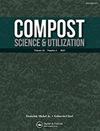Monitoring: Physic‐Chemical, Microbiological, and Phytotoxic Parameters of Mixed Oil Mill Waste and Green Waste Composts Moistened with Treated Urban Wastewater and Tap Water
IF 0.9
4区 农林科学
Q3 ECOLOGY
引用次数: 4
Abstract
Abstract In Tunisia, on‐site co‐composting of oil mill waste would overcome environmental issues and valorize renewable resources. The authors' goal was to determine the physic‐chemical and microbiological properties and nutrient supply characteristics of mixed oil mill waste and green waste compost. Two piles of the same raw materials (2/3 oil mill waste–1/3 green waste, w/w) were moistened with two kinds of water: treated urban wastewater (A1) and tap water (A2). Results showed the following: (i) produced compost decreased in C/N from 32 to 12.30 ± 0.89 (A1) and 11 ± 0.89 (A2); (ii) major elements (P and K) were within acceptable limits; (iii) A1 and A2 had potentially lower heavy metal contents than the limits established by the second draft of the Biological Treatment of Biowaste of the European Commission and microbial load values below the limit N FU 44‐051 values; (iv) A1 and A2 had, respectively, 93 and 89.67% as germination index Gl values, which confirmed the composts' maturity and safety; (v) for both composts, A1 and A2, culture potting made up of half compost and half soil revealed the highest bean leaves' number; and (vi) the less richness in minerals and organic compounds of A2 compared to A1 gave better germination results for white wheat and bean leaves' number for A2. Even moistened with treated urban waste water, oil mill wastes proved to be very interesting for co‐composting with green waste.监测:经处理的城市污水和自来水润湿的混合油厂废物和绿色废物堆肥的物理化学、微生物和植物毒性参数
在突尼斯,现场共同堆肥的油厂废物将克服环境问题和价值可再生资源。作者的目的是确定混合油厂废弃物和绿色废弃物堆肥的理化、微生物特性和养分供应特性。用处理过的城市污水(A1)和自来水(A2)两种水润湿两堆相同的原料(2/3油厂废水- 1/3绿色废弃物,w/w)。结果表明:(1)产堆肥C/N由32降至12.30±0.89 (A1)和11±0.89 (A2);(ii)主要元素(磷和钾)在可接受范围内;(iii) A1和A2的重金属含量可能低于欧盟委员会生物废物生物处理第二稿确定的限值,微生物负荷值低于限值N FU 44‐051;(iv) A1和A2的萌发指数Gl值分别为93和89.67%,表明堆肥的成熟度和安全性较高;(v)对于A1和A2两种堆肥,一半堆肥一半土壤的栽培盆栽显示出最高的豆叶数;(6)由于A2土壤中矿物质和有机物的丰富度低于A1,因此A2的白小麦和豆类叶片数量萌发效果较好。即使用处理过的城市废水进行润湿处理,油厂废物也被证明是非常有趣的,可以与绿色废物共同堆肥。
本文章由计算机程序翻译,如有差异,请以英文原文为准。
求助全文
约1分钟内获得全文
求助全文
来源期刊

Compost Science & Utilization
农林科学-生态学
CiteScore
4.10
自引率
0.00%
发文量
0
审稿时长
>36 weeks
期刊介绍:
4 issues per year
Compost Science & Utilization is currently abstracted/indexed in: CABI Agriculture & Environment Abstracts, CSA Biotechnology and Environmental Engineering Abstracts, EBSCOhost Abstracts, Elsevier Compendex and GEOBASE Abstracts, PubMed, ProQuest Science Abstracts, and Thomson Reuters Biological Abstracts and Science Citation Index
 求助内容:
求助内容: 应助结果提醒方式:
应助结果提醒方式:


